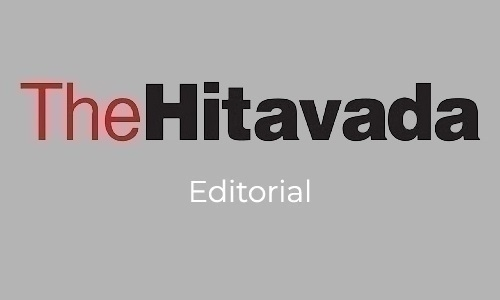CENTRAL Government bringing a counter-terrorism policy soon, is a timely step in right direction. Since the statement in this regard has come from none other than Union Home Minister Mr. Amit Shah, it has the seal of credibility too.
| Date :09-Nov-2024 |

CENTRAL Government bringing a counter-terrorism policy soon, is a timely step in right direction. Since the statement in this regard has come from none other than Union Home Minister Mr. Amit Shah, it has the seal of credibility too. Given the track record of Prime Minister Mr. Narendra Modi as well as Mr. Shah, they are serious about walking the talk. Rather, they are known for doing their home-work well in advance and paving way for a decision to be implemented, before they make public the plan.
The counter-terrorism policy will be a major initiative in the history of India. For long years, India has been facing different kinds of terrorism. Some are supported by external forces, some are products of hostile segments within society, and some are kept alive by the dynamics of power politics.
Then, there are multiple challenges posed due to the terrorists’ areas of operation that range from hill tracts in parts of North-East to Jammu and Kashmir, from coastal areas to tribal areas, from forested and mineral-rich territories to urban centres. The extremists, separatists, and terrorists active in different parts of the country statedly profess different causes and ideologies, but their goal is only one -- to overthrow the Government of the day in India.
Given this vast diversity with which the forces inimical to India operate, the country really needed a well-coordinated counter-terrorism policy. As is a common knowledge in security apparatus, there have been several slip-ups because of issues pertaining to jurisdiction when it came to police force from one State taking action against outlaws in adjoining State. This gradually led to formation of inter-State task forces. But, those had limited utility and purpose. With the advent of technology and seamless transfer of funds, the terrorists too have evolved.
From the Maoists to Khalistanis to jehadis operating in Jammu and Kashmir to ethnic extremist groups in the North-East, these forces believing in taking to arms against the Constitutionally elected Government have been trying to seek each other’s co-operation. This aim of forming an ‘arc of terror’ needs an effectively co-ordinated action from the Government agencies at multiple levels. This calls for induction and use of technology, sharing of actionable intelligence, faster co-ordination using technological advances, expedited mobilisation of forces whenever needed, and enhanced operational readiness of the troops. Of course, this involves a plethora of agencies including the Intelligence Bureau, the National Investigation
Agency, the Enforcement Directorate, the State intelligence and police departments, para-military forces. Each one has different command and control structure, as well as standard operating procedures.
Hence, having uniform guidelines for standard operating procedures, with scope for regional variations as per local conditions, was needed. Also needed was a robust mechanism to counter the menace of terrorism, terrorists, and their ‘ecosystem’. Against this backdrop, Mr. Amit Shah stating that the Government has come up with a vision for a model anti-terrorism squad (ATS) and model special task force (STF), needs to be welcome by everyone concerned about the national security, particularly the internal or homeland security. While doing so, the Government will have to take care of political dynamics too. For, there are certain political parties that have myopic vision about anything and everything. If some political parties oppose wider security overhaul to effectively fight the scourge of terrorism in the country, intelligentsia and judiciary and common people may need to support the Government with apolitical commitment to the cause of national interest.
Another aspect that must be taken into account is the legal framework. The country has seen what happened to the Terrorist and Disruptive Activities (Prevention) Act or TADA and also the Prevention of Terrorism Act or POTA. Though there were excesses, these laws also enabled the agencies in cracking down on terrorists. Presently, action is being taken against terrorists, especially the jehadis and the Maoists, under the provisions of the Unlawful Activities Prevention Act or UAPA. However, these provisions are being opposed by activists and even some foreign organisations. Often, they try to cast a shadow of suspicion on the action taken by the Government against the terrorists and their ‘ecosystem’.
With time, the Indian legal system also has evolved as reflected in the coming into force of the Bharatiya Nyaya Sanhita. Still, when it comes to tackling the ‘ecosystem’, definitions are either not available in existing laws or the terminology is too weak. Either the respective States should come up with their own versions of Public Security Act, since law and order is a State subject, or the existing laws should incorporate enabling provisions. Else, the security agencies nabbing terrorists and their sympathisers or supporters cut a sorry figure when lack of supportive legal provisions leads to acquittal of the accused on technical grounds. Increasing conviction in terror-related cases needs to be paid heed to while enforcing the larger counter-terrorism policy.
This will have to be backed by some more effort at synchronisation of resources -- manpower, technology, human intelligence and electronic intelligence, and collaborative diplomacy -- to tackle the terror threat emanating from foreign soil. The global community has realised the need for collective action against drug-terror-trafficking nexus. But, the issues relating to extradition continue to pose challenge. Gradually, with the counter-terrorism policy, India will have to champion the cause of borderless action against terrorism, which is a crime against humanity.
